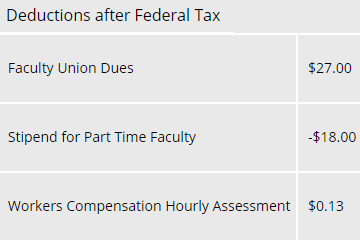2 Negative Numbers

Negative numbers are a fact of life, from winter temperatures to our bank accounts. (And occasionally elevators, if they go underground.)
Before we start calculating with negative numbers, we’ll take a look at absolute value. This will make it easier for us to talk about what we’re doing when we add, subtract, multiply, or divide signed numbers.
Absolute Value
The absolute value of a number is its distance from ![]() . You can think of it as the size of a number without identifying it as positive or negative. Numbers with the same absolute value but different signs, such as
. You can think of it as the size of a number without identifying it as positive or negative. Numbers with the same absolute value but different signs, such as ![]() and
and ![]() , are called opposites. The absolute value of
, are called opposites. The absolute value of ![]() is
is ![]() , and the absolute value of
, and the absolute value of ![]() is also
is also ![]() , because both numbers are
, because both numbers are ![]() units away from
units away from ![]() .
.
We use a pair of straight vertical bars to indicate absolute value; for example, ![]() and
and ![]() .
.
Exercises
Evaluate each expression.
Adding Negative Numbers
Exercises
Perform each addition.
To add a positive number and a negative number, we subtract the smaller absolute value from the larger. If the positive number has the larger absolute value, the final answer is positive. If the negative number has the larger absolute value, the final answer is negative.
Exercises
Perform each addition.




- The temperature at noon on a chilly Monday was
 °F. By the next day at noon, the temperature had risen
°F. By the next day at noon, the temperature had risen  °F. What was the temperature at noon on Tuesday?
°F. What was the temperature at noon on Tuesday?
If an expression consists of only additions, we can break the rules for order of operations and add the numbers in whatever order we choose.
Exercises
Evaluate each expression using any shortcuts that you notice.
Subtracting Negative Numbers

Exercises
Perform each subtraction.
Absolute Value, Revisited
Absolute value can be useful when we want to find the difference between two numbers but we want the result to be positive. For example, suppose that the temperature in Portland, Oregon is ![]() °F, and the temperature in Portland, Maine is
°F, and the temperature in Portland, Maine is ![]() °F. What is the difference in temperature? The simplest way to find the difference is to do
°F. What is the difference in temperature? The simplest way to find the difference is to do ![]() , and you would report that as a difference of “fifty-five degrees Fahrenheit”. If you instead did
, and you would report that as a difference of “fifty-five degrees Fahrenheit”. If you instead did ![]() , it would sound a bit strange to say the the difference is “negative fifty-five degrees Fahrenheit” and you would most likely ignore the negative sign when reporting the difference. To guarantee that the result of a subtraction is positive, we can put absolute value bars around the entire calculation. This is sometimes called the positive difference.
, it would sound a bit strange to say the the difference is “negative fifty-five degrees Fahrenheit” and you would most likely ignore the negative sign when reporting the difference. To guarantee that the result of a subtraction is positive, we can put absolute value bars around the entire calculation. This is sometimes called the positive difference.
Exercises
Evaluate each expression.


- The lowest point in Colorado is on the Arikaree River, with an elevation
 feet above sea level. The highest point in Colorado is the peak of Mount Elbert, with an elevation
feet above sea level. The highest point in Colorado is the peak of Mount Elbert, with an elevation  feet above sea level.[1] Find the positive difference between these elevations.
feet above sea level.[1] Find the positive difference between these elevations. - The lowest point in Louisiana is in New Orleans, with an elevation
 feet below sea level. The highest point in Louisiana is the peak of Driskill Mountain, with an elevation
feet below sea level. The highest point in Louisiana is the peak of Driskill Mountain, with an elevation  feet above sea level.[2] Find the positive difference between these elevations.
feet above sea level.[2] Find the positive difference between these elevations.
Multiplying Negative Numbers
Suppose you spend ![]() dollars on a coffee every day. We could represent spending 3 dollars as a negative number,
dollars on a coffee every day. We could represent spending 3 dollars as a negative number, ![]() dollars. Over the course of a
dollars. Over the course of a ![]() -day work week, you would spend
-day work week, you would spend ![]() dollars, which we could represent as
dollars, which we could represent as ![]() dollars. This shows that
dollars. This shows that ![]() , or
, or ![]() .
.
Exercises
Find each product.
Going back to our coffee example, we saw that ![]() . Therefore, the opposite of
. Therefore, the opposite of ![]() must be positive
must be positive ![]() . Because
. Because ![]() is the opposite of
is the opposite of ![]() , this implies that
, this implies that ![]() .
.
WARNING! These rules are different from the rules for addition; be careful not to mix them up.
Exercises
Find each product.
Recall that an exponent represents a repeated multiplication. Let’s see what happens when we raise a negative number to an exponent.
Exercises
Evaluate each expression.
If a negative number is raised to an odd power, the result is negative.
Dividing Negative Numbers
Let’s go back to the coffee example we saw earlier: ![]() . We can rewrite this fact using division and see that
. We can rewrite this fact using division and see that ![]() ; a negative divided by a positive gives a negative result. Also,
; a negative divided by a positive gives a negative result. Also, ![]() ; a negative divided by a negative gives a positive result. This means that the rules for division work exactly like the rules for multiplication.
; a negative divided by a negative gives a positive result. This means that the rules for division work exactly like the rules for multiplication.
If two numbers with the same sign are divided, the quotient is positive.
Exercises
Find each quotient.
Go ahead and check those last three exercises with a calculator. Any surprises?
0 divided by another number is 0.
A number divided by 0 is undefined, or not a real number.
Here’s a quick explanation of why ![]() can’t be a real number. Suppose that there is a mystery number, which we’ll call
can’t be a real number. Suppose that there is a mystery number, which we’ll call ![]() , such that
, such that ![]() . Then we can rewrite this division as a related multiplication,
. Then we can rewrite this division as a related multiplication, ![]() . But because
. But because ![]() times any number is
times any number is ![]() , the left side of this equation is
, the left side of this equation is ![]() , and we get the result that
, and we get the result that ![]() , which doesn’t make sense. Therefore, there is no such number
, which doesn’t make sense. Therefore, there is no such number ![]() , and
, and ![]() cannot be a real number.
cannot be a real number.
Order of Operations with Negative Numbers
P: Work inside of parentheses or grouping symbols, following the order PEMDAS as necessary.
E: Evaluate exponents.
MD: Perform multiplications and divisions from left to right.
AS: Perform additions and subtractions from left to right.
Exercises
Evaluate each expression using the order of operations.
the distance a number is from 0
numbers with the same absolute value but different signs
the absolute value of the result of subtracting two numbers

